sensor AUDI S8 2013 Owner's Guide
[x] Cancel search | Manufacturer: AUDI, Model Year: 2013, Model line: S8, Model: AUDI S8 2013Pages: 318, PDF Size: 79.34 MB
Page 173 of 318
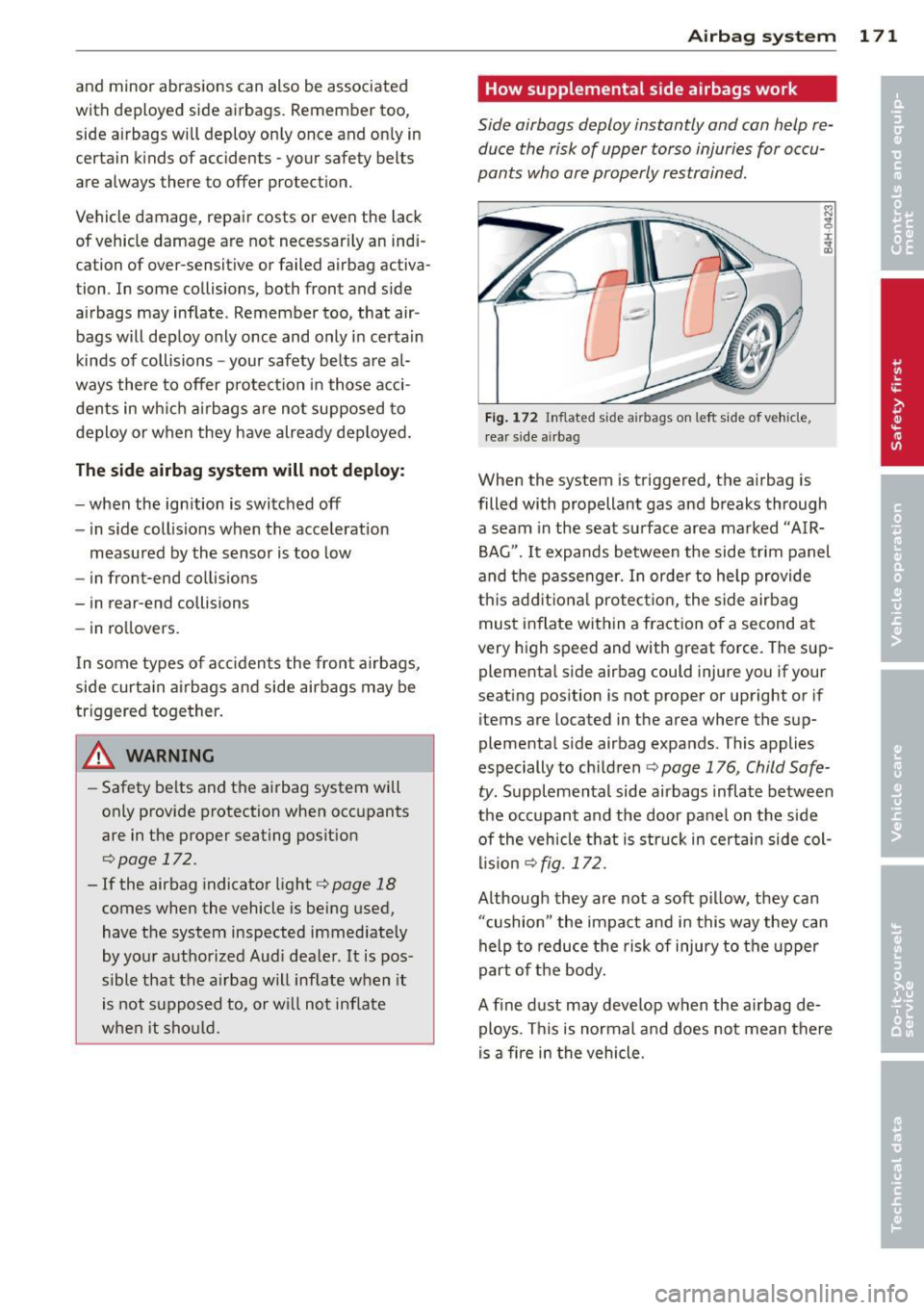
and minor abrasions can also be associated
with deployed side airbags. Remember too,
side airbags will deploy only once and on ly in
certain k inds of accidents -your safety belts
are always there to offer protect ion.
Vehicle damage, repair costs or even the lack
of vehicle damage are not necessar ily an indi Ā
cation of over-sensitive or failed airbag activaĀ
tion . In some collisions, both front and s ide
a irbags may inf late . Remember too, that air Ā
bags will deploy only once and only in certain
kinds of collisions -your safety belts are alĀ
ways there to offer protect ion in those acciĀ
dents in wh ic h airbags are not supposed to
deploy or w hen they have already deployed .
The side airbag system will not depl oy :
- when the ignition is switched off
- in s ide collisions when the acceleration
measured by the sensor is too low
- in front-end collisions
- in rear-end collisions
- in ro llovers.
I n some types of a ccidents the front a irbags,
side curta in a irbags and side airbags may be
triggered together.
A WARNING
- Safety belts and the airbag system will
only provide protection when occupants
are in the proper seating posit ion
<=)page 172.
- If the airbag indicator light Q page 18
comes when the vehicle is be ing used,
have the system inspected immediately
by you r aut ho rized Aud i dealer. It is posĀ
sible that the a irbag will inflate when it
is not supposed to, or w ill not inflate
when it should.
-
A irba g sy stem 1 71
How supplemental side airbags work
Side airbags deploy instantly and can help reĀ
duce the risk of upper torso injuries for occuĀ
pants who are properly restrained.
Fig . 1 72 Inflated side a irbags on left side of vehicle ,
rear side airbag
When the system is triggered, the a irbag is
filled with propellant gas and breaks through
a seam in the seat surface area ma rked ''AIRĀ
BAG".
It expands between the side trim panel
and the passenger. In orde r to help provide
th is add it ional protect ion, the side airbag
must inflate within a fraction o f a second at
very high speed and with great force. The supĀ
plementa l side airbag could injure you if your
seat ing position is not proper or upright or if
items are located in the area where the supĀ
plementa l side airbag expands . This applies
especially to child ren
Q page 176, Child SafeĀ
ty. Supplemental side airbags inflate between
the occupant and the door panel on the side
of the vehicle that is struck in certa in side co lĀ
lis ion
Q fig. 172.
Although they are not a soft pi llow, they can
"cushion" the impa ct and in this way they can
help to reduce t he risk of injury to the upper
part o f th e body.
A fine dust may deve lop when the airbag deĀ
ploys . This is normal and does not mean there
is a fire in the vehicle.
Page 174 of 318
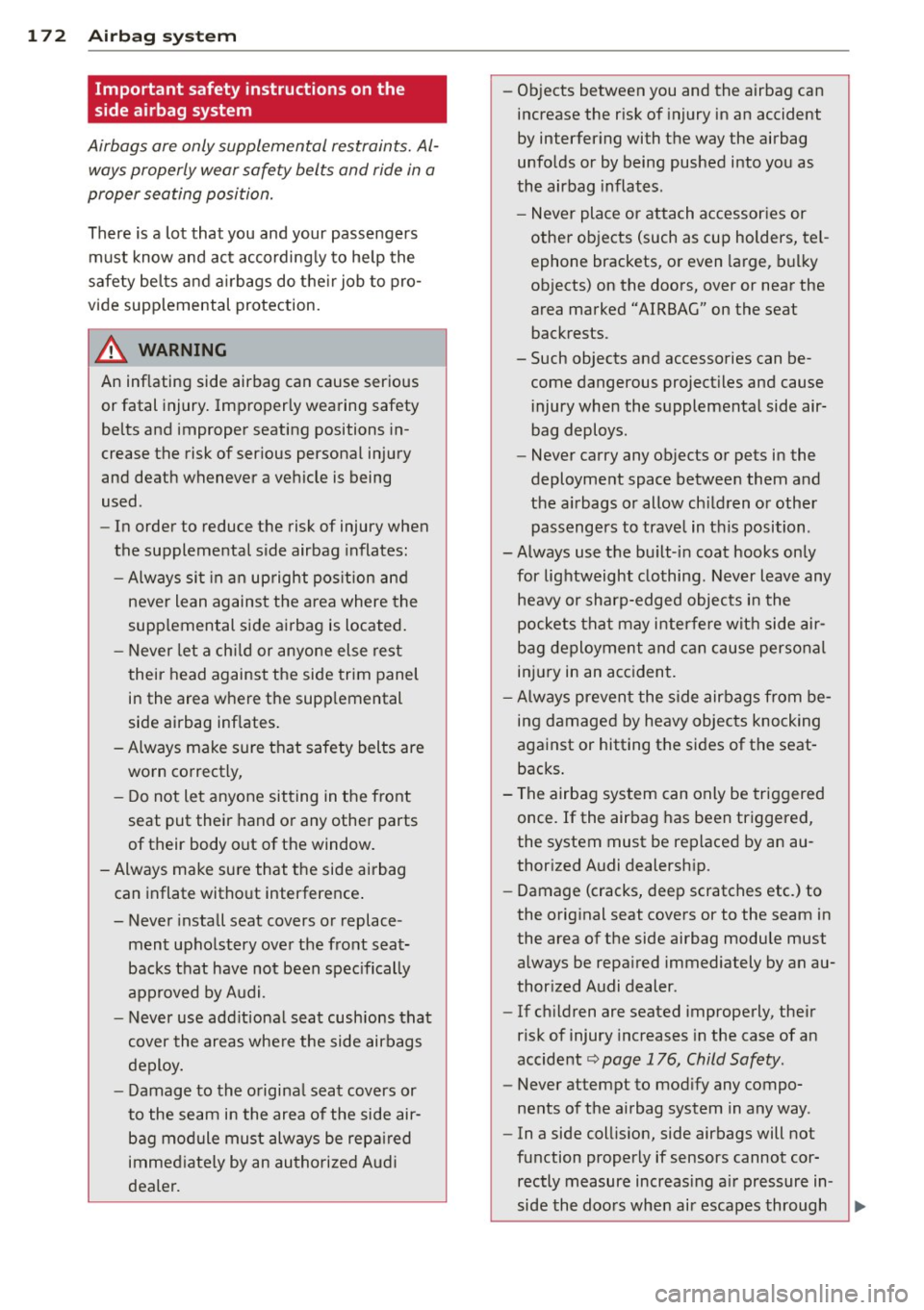
172 Airbag system
Important safety instructions on the
side airbag system
Airbags are only supplemental restraints. AlĀ
ways properly wear safety belts and ride in a
proper seating position.
There is a lot that you and your passengers
must know and act accordingly to help the
safety belts and airbags do their job to proĀ
vide supplemental protection.
& WARNING
An inflating side airbag can cause serious
or fatal injury. Improperly wearing safety
belts and improper seating positions inĀ
crease the risk of serious personal injury
and death whenever a vehicle is being
used.
- In order to reduce the risk of injury when
the supplemental side airbag inflates:
- Always sit in an upright position and
never lean against the area where the
supplemental side airbag is located.
- Never let a child or anyone else rest
their head against the side trim panel
in the area where the supplemental
side airbag inflates.
-Always make sure that safety belts are worn correctly,
- Do not let anyone sitting in the front
seat put their hand or any other parts
of their body out of the window.
-Always make sure that the side airbag can inflate without interference.
- Never install seat covers or replaceĀ
ment upholstery over the front seatĀ
backs that have not been specifically
approved by Audi.
- Never use additional seat cushions that
cover the areas where the side airbags
deploy.
- Damage to the original seat covers or
to the seam in the area of the side airĀ
bag module must always be repaired
immediately by an authorized Audi
dealer. -
Objects between you and the airbag can
increase the risk of injury in an accident
by interfering with the way the airbag
unfolds or by being pushed into you as
the airbag inflates.
- Never place or attach accessories or
other objects (such as cup holders, telĀ
ephone brackets, or even large, bulky
objects) on the doors, over or near the
area marked "AIRBAG" on the seat backrests.
- Such objects and accessories can beĀ come dangerous projectiles and cause
injury when the supplemental side airĀ
bag deploys.
- Never carry any objects or pets in the
deployment space between them and
the airbags or allow children or other passengers to travel in this position.
-Always use the built-in coat hooks only for lightweight clothing. Never leave any
heavy or sharp-edged objects in the
pockets that may interfere with side airĀ
bag deployment and can cause personal
injury in an accident.
- Always prevent the side airbags from beĀ
ing damaged by heavy objects knocking
against or hitting the sides of the seatĀ
backs.
- The airbag system can only be triggered
once. If the airbag has been triggered,
the system must be replaced by an auĀ
thorized Audi dealership.
- Damage (cracks, deep scratches etc.) to
the original seat covers or to the seam in
the area of the side airbag module must always be repaired immediately by an auĀ
thorized Audi dealer.
- If children are seated improperly, their
risk of injury increases in the case of an
accident
~ page 176, Child Safety.
- Never attempt to modify any compoĀ
nents of the airbag system in any way .
- In a side collision, side airbags will not
function properly if sensors cannot corĀ rectly measure increasing air pressure in-
side the doors when air escapes through ..,.
Page 175 of 318
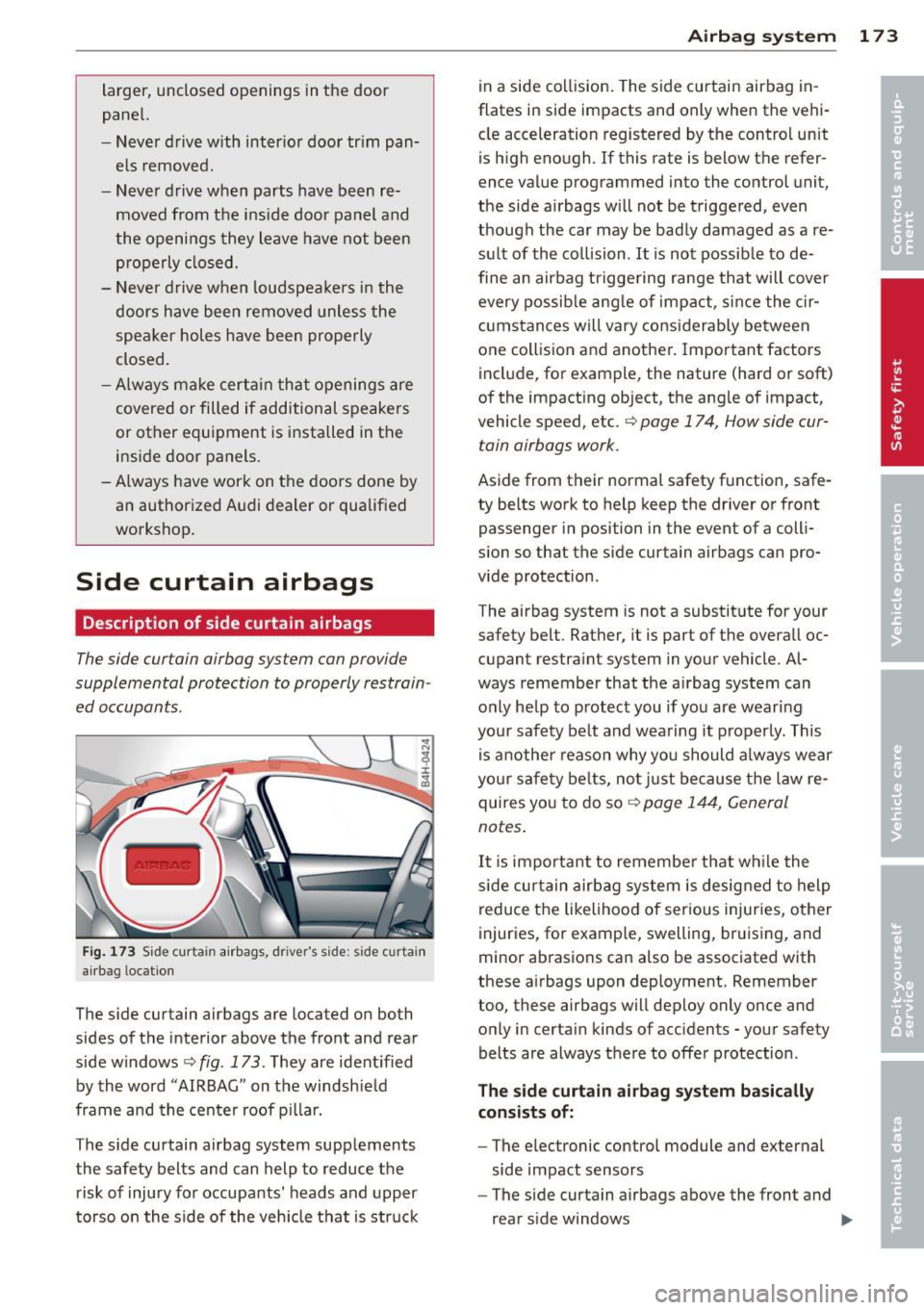
larger, unclosed openings in the door
panel.
- Never d rive w ith int erio r door tr im panĀ
els removed.
- Never d rive when parts have been reĀ
moved from t he ins ide door panel and
the openings they leave have not been
p roperly closed.
- Never d rive w hen loudspeakers in the
doors have been removed unle ss the
spea ker holes have been properly
closed.
- Always make cer ta in t hat openings are
covered or filled if additional s peake rs
or other equi pment is i nstalled in the
insi de door panels.
- A lways have work on t he doors done by
a n author ized Audi dealer or qualified
wo rkshop .
Side curtain airbags
Description of side curtain airbags
The side curtain airbag system can provide
supplemental protection to properly restrain Ā
ed occupants.
Fi g. 173 Side curtai n airbags, dr iver 's s ide: side curtai n
ai rbag locat ion
The side curtain airbags are located on both
sides of the interior above the front and rear
side windows Ā¢
fig. 173. They are ident ified
by the word "AIRBAG" on the windshie ld
frame and the center roof p illar.
The side curtain airbag system supp lements
the safety belts and can help to reduce the risk of injury for occupa nts' heads and upper
torso on the side of the veh icle tha t is struc k
Airba g system 173
in a side co llision . The side cu rtain airbag inĀ
flates in side impacts and only when the vehiĀ
cle acceleration registered by the contro l un it
is h igh eno ugh. If this rate is below the referĀ
ence value programmed into the control unit,
the side airbags will not be triggered, even
though the car may be badly damaged as a reĀ
su lt of the co llision . It is not possib le to deĀ
fine an airbag triggering range that will cover every possib le ang le of impa ct, sin ce the cirĀ
c u mstances will vary cons iderably be tween
one collision and anothe r. Important factors
incl ude, fo r example, the nature (hard or soft)
of the impacting object, the ang le of impact,
vehicle speed, etc . Ā¢
page 17 4, How side curĀ
tain airbags work.
Aside from their normal safety f unction, safeĀ
ty belts work to help keep the driver or front passenger in position in the event of a coll iĀ
s ion so that the side curtain airbags can proĀ
vide protection .
The airbag system is not a substit ute for your
safety belt. Rather, it is part of the overall ocĀ cupant restra int system in your vehicle. AlĀ
ways remember that the a irbag system can
o nly help to protec t you if you are wear ing
you r safety be lt and wea ring it p roperly. This
i s a nothe r reason why you should a lways wear
yo ur safe ty be lts, no t ju st because the law reĀ
quires you to do so Ā¢
page 144, General
notes .
It is impo rtant to remembe r that w hile the
s id e cu rtain air bag system is desig ned to help
reduce t he likelihood of serious injuries, other
injur ies, for examp le, swelling, br uising, and
minor ab rasions can also be associated with
these a irbags upon deployment. Remember
too, these airbags will deploy only once and
o nly in certain kinds of acc idents -your safety
belts are always the re to offer protection .
The side curtain airbag sy stem ba sically
consists of :
-The e lectronic control module and external
side impact sensors
- The side curtain airbags above the front and
rea r side windows
Page 176 of 318

17 4 Airbag system
-The airbag indicator light in the instrument
panel
The airbag sys tem is monitored electro nica lly
to make certa in it is funct ion ing properly a t all
times. Each time you switch on the ignition,
the a irbag system ind icator light wi ll come on
for a few seconds (self diagnost ics).
The side curtain airb ag i s not activated :
-if the ignit ion is switched off,
- in s ide collisions when the acceleration
measured by the sensor is too low ,
- in rear-end collisions,
- in rollovers .
A WARNING
-
-Safety belts and the a irbag system will
only p rov ide protection when occ upants
are in t he p roper sea ting posit ion
c>page 57, General recommendations.
- If the airbag indicato r ligh tĀ¢ page 18
comes whe n the vehicle is be ing used,
have the system inspected immediate ly
by your aut horized Aud i dea ler . It is posĀ
sible that the airbag will inflate when it is not s upposed to, or w ill not inflate
when it should.
How side curtain airbags work
Side curtain airbags can work tog ether with
sid e airbags to h elp reduc e the risk of head
and upper torso i njurie s for occupants who
are properly res trained.
F ig . 17 4 Illust rat ion of p rin cipl e: In fl ate d side cu rt a in
airba gs on th e left sid e
The side curtain airbags inflate between the
occupant and the windows on the side of the
"' N ;g
:i: .. m
vehicle that is struck in a side collis ion
Ā¢ fig . 174 .
When the system is triggered, the side curta in
airbag is filled w ith prope llant gas and breaks
through a seam above the front and rear side
windows identified by th e AIRBAG label. In orĀ·
der to he lp provide this add itiona l protection,
the side curta in a irbag must inflate within the
blink of an eye at very high speed and with
great force . The side curta in a irbag could in Ā·
jure you if your seating pos it io n is not proper
o r upright or if items are located in the area
whe re the supplemental side curta in a irbag
infla tes. This applies especially to ch ild ren
Ā¢ page 176.
Although they are not a soft pi llow, side curĀ·
ta in a irbags can "cushion" the impact and i n
th is way they can help to reduce the risk of inĀ
j u ry to the head and the uppe r part o f the
body.
A fine dust may deve lop w hen the airbag deĀ·
ploys. Th is is qui te no rma l and does not mean
there is a fire in the vehicle .
Important safety instructions on the
side curtain airbag system
Airbags are only supplemental restraints . AlĀ·
ways properly wear safety belts and rid e in a
proper seating position .
The re is a lot that you and your passengers
must know and do to he lp the safety belts and
airbags do th eir job to provide supp lemental
protection .
A WARNING
-Improperly wearing safety belts and im-
p roper seating posit ions increase the risk
of ser ious personal inju ry and death whenĀ·
ever a vehicle is being used.
- Never let occupants place any parts of
their bod ies in the area from which the
side curta in a irbags inflate.
- Always make sure that the s ide curtain
airbags can inflate without interference .
Unsui table ac cessories fitted inside the
-
Page 179 of 318
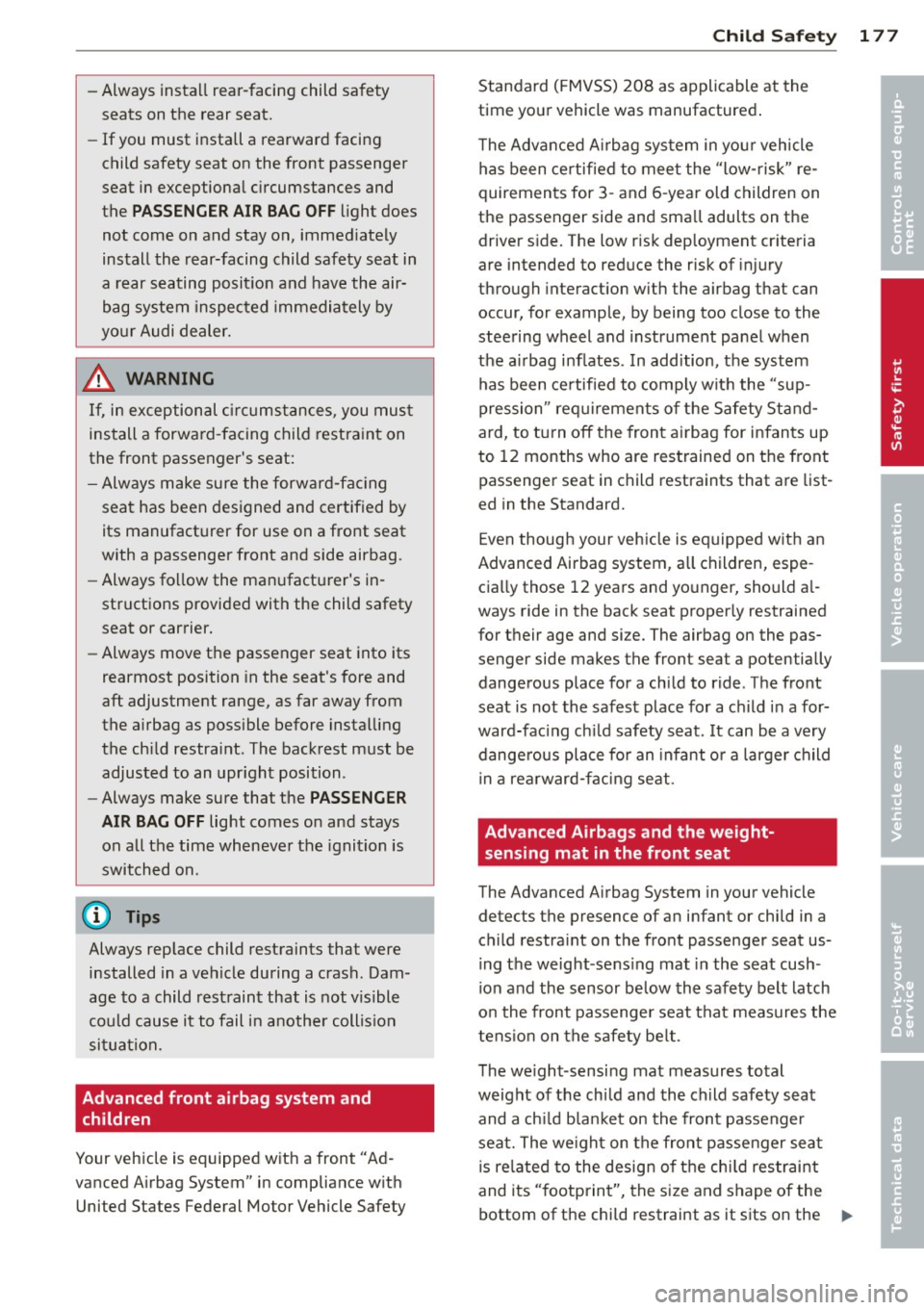
-Always install rear-facing child safety
seats on the rear seat.
- If you must install a rearward facing
child safety seat on the front passenger
seat in exceptional circumstances and
the
PASSENGER AIR BAG OFF light does
not come on and stay on, immediately
install the rear-facing child safety seat in
a rear seating position and have the airĀ
bag system inspected immediately by
your Audi dealer.
_& WARNING
If, in exceptional circumstances, you must
install a forward-facing child restraint on
the front passenger's seat:
- Always make sure the forward-facing
seat has been designed and certified by its manufacturer for use on a front seat
with a passenger front and side airbag.
- Always follow the manufacturer's inĀ
structions provided with the child safety
seat or carrier.
- Always move the passenger seat into its
rearmost position in the seat's fore and
aft adjustment range, as far away from
the airbag as possible before installing
the child restraint. The backrest must be
adjusted to an upright position .
- Always make sure that the
PASSENGER
AIR BAG OFF
light comes on and stays
on all the time whenever the ignition is
switched on.
(D Tips
Always replace child restraints that were
installed in a vehicle during a crash. DamĀ
age to a child restraint that is not visible
could cause it to fail in another collision
situation.
Advanced front airbag system and children
Your vehicle is equipped with a front "AdĀ
vanced Airbag System" in compliance with United States Federal Motor Vehicle Safety
Child Safety 177
Standard (FMVSS) 208 as applicable at the
time your vehicle was manufactured.
The Advanced Airbag system in your vehicle
has been certified to meet the "low-risk" reĀ
quirements for 3- and 6-year old children on
the passenger side and small adults on the driver side. The low risk deployment criteria
are intended to reduce the risk of injury
through interaction with the airbag that can
occur, for example, by being too close to the
steering wheel and instrument panel when
the airbag inflates . In addition, the system
has been certified to comply with the "supĀ
pression" requirements of the Safety StandĀ
ard, to turn off the front airbag for infants up
to 12 months who are restrained on the front
passenger seat in child restraints that are listĀ
ed in the Standard.
Even though your vehicle is equipped with an
Advanced Airbag system, all children, espeĀ cially those 12 years and younger, should alĀ
ways ride in the back seat properly restrained
for their age and size. The airbag on the pasĀ
senger side makes the front seat a potentially dangerous place for a child to ride . The front
seat is not the safest place for a child in a forĀ
ward-facing child safety seat. It can be a very
dangerous place for an infant or a larger child
in a rearward-facing seat .
Advanced Airbags and the weightĀ
sensing mat in the front seat
The Advanced Airbag System in your vehicle
detects the presence of an infant or child in a
child restraint on the front passenger seat usĀ
ing the weight -sensing mat in the seat cushĀ
ion and the sensor below the safety belt latch
on the front passenger seat that measures the
tension on the safety belt.
The weight -sensing mat measures total
weight of the child and the child safety seat
and a child blanket on the front passenger seat. The weight on the front passenger seat
is related to the design of the child restraint
and its "footprint", the size and shape of the
bottom of the child restraint as it sits on the ..,.
ā¢
ā¢
Page 180 of 318
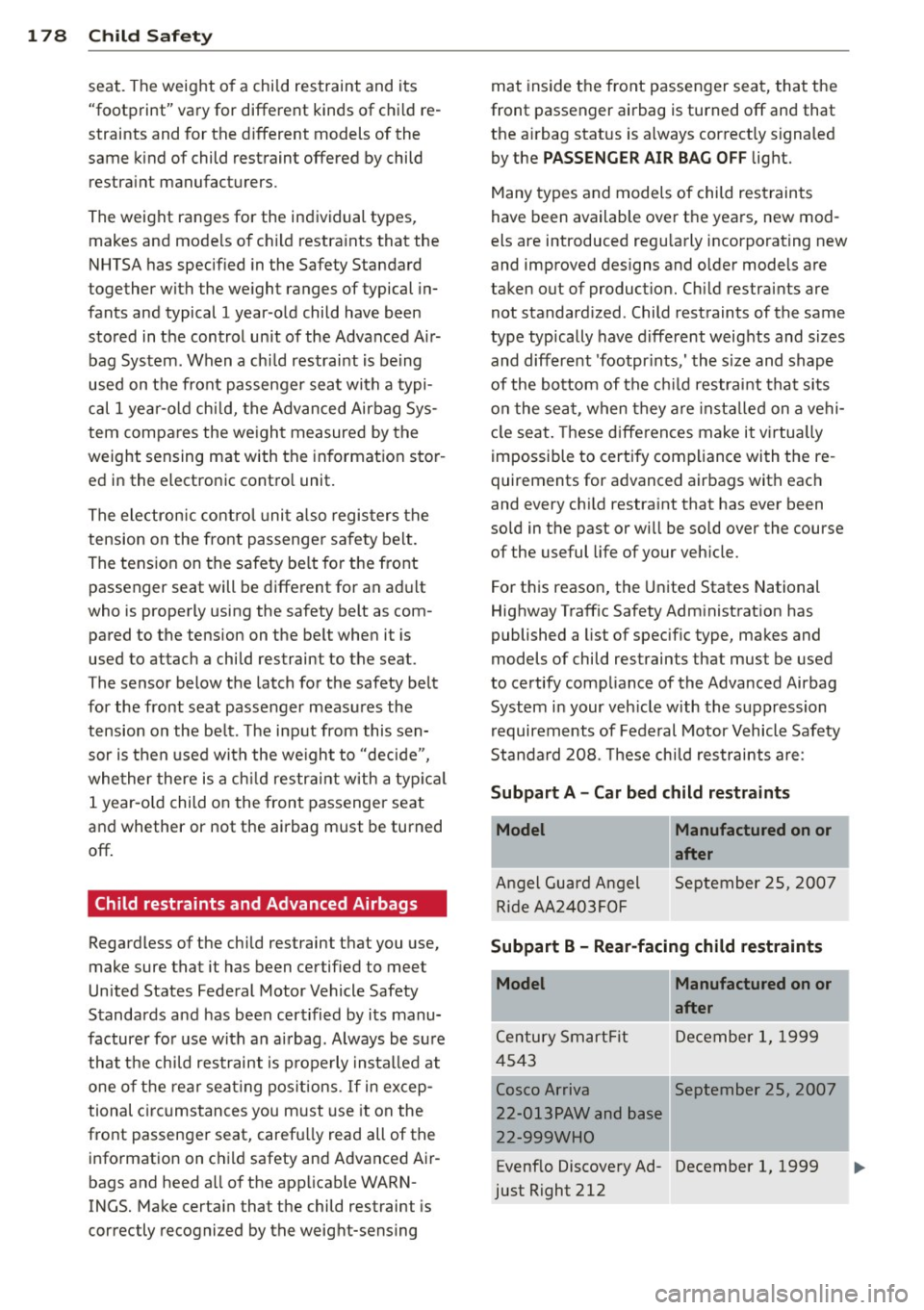
178 Child Saf ety
seat. The weight of a child restraint and its
"footprint" vary for different kinds of chi ld reĀ
straints and for the d ifferent models of the
same kind of child restraint offered by child
restra int manufacturers.
The weight ranges for the individual types,
makes and mode ls of ch ild restra ints that the
NHTSA has specified in the Safety Standard
together with the weight ranges of typical inĀ
fants and typical 1 year-old child have been
stored in the control unit of the Advanced A irĀ
bag System. When a ch ild restrai nt is being
used on the front passenger seat with a typi Ā
cal 1 yea r-old ch ild, the Advanced Airbag SysĀ
tem compares the we ight measured by the
weight sensing mat with the in formation storĀ
ed in the electronic control unit.
The ele ctron ic cont rol unit also registers the
tension on the front passenge r safety belt.
The tension on the safety be lt fo r the front
passenger seat will be different for an ad ult
who is properly using the safety belt as comĀ
pared to the tension on the belt when it is
used to attach a child restraint to the seat.
The sensor below the latch for the safety belt
for the front seat passenger measu res the
tension on the be lt. The input from this senĀ
sor is then used with the we ight to "decide",
whe ther there is a ch ild restraint w ith a typ ica l
1 year-o ld child on the front passenger seat
and whether or not the airbag must be turned
off .
Child restraints and Advanced Airbags
Regardless of the child restraint that you use,
make sure that it has been certified to meet
United States Federal Motor Vehicle Safety
Standards a nd has been certified by its manuĀ
facture r fo r u se w ith an airbag. Always be s ure
that t he ch ild res traint is p rope rly insta lled at
one o f th e rear seat ing pos itions. If in excepĀ
tional c ircu mstances you must use it on the
front passenger seat, caref ully read all of the
info rmation on c hild safety and Advanced AirĀ
bags and heed all of the applicable WARNĀ
INGS. Make certain that the child restraint is
correctly recognized by the weig ht-sensing mat
inside the front passenger seat, that the
front passenger airbag is turned off and that
the a irbag stat us is always cor rect ly signa led
by the
PASSENGER AIR BAG OFF light.
Many types and models of child res traints
have been available over the years, new modĀ
els are introduced regu larly incorporating new
and improved des igns and older models are
taken out of product ion. Ch ild restraints are
not standard ized . Child restraints of the same
type typically have d ifferent weights and sizes
and diff erent 'footpr ints,' the s ize and shape
of the bo ttom of the ch ild restra int that sits
o n t he seat, when they a re inst alled on a vehiĀ
cle sea t. Th ese d ifferences make it vir tually
impossible to certify compliance with the re Ā
quirements for advanced airbags with eac h
and every child restra int that has ever been
sold in the past or will be sold over the course
of the useful life of your veh icle.
For th is reason, the United States National
Highway Traffic Safety Adm inistrat ion has
published a list of specific type, makes and
models of child restraints that must be used
to certify comp liance of the Advanced Airbag
System i n your veh icle w ith the suppression
requirements of Federal Motor Vehicle Safety
Standa rd 208. These chi ld restraints are:
Subpart A - Car bed child restraints
Model
Angel Guard Angel R ide AA 2403FOF
Manufactured on or
after
September 25, 200 7
Subpart B - Rear-facing child restraints
Model Manufactured on or
after
Century SmartFit Dece mber 1, 1999
4543
Cosco Arriva September 25, 2007
22-013PAW and base
22-999W HO
Evenf lo Discove ry Ad -December 1, 1999
just Right 212
I
....
Page 198 of 318
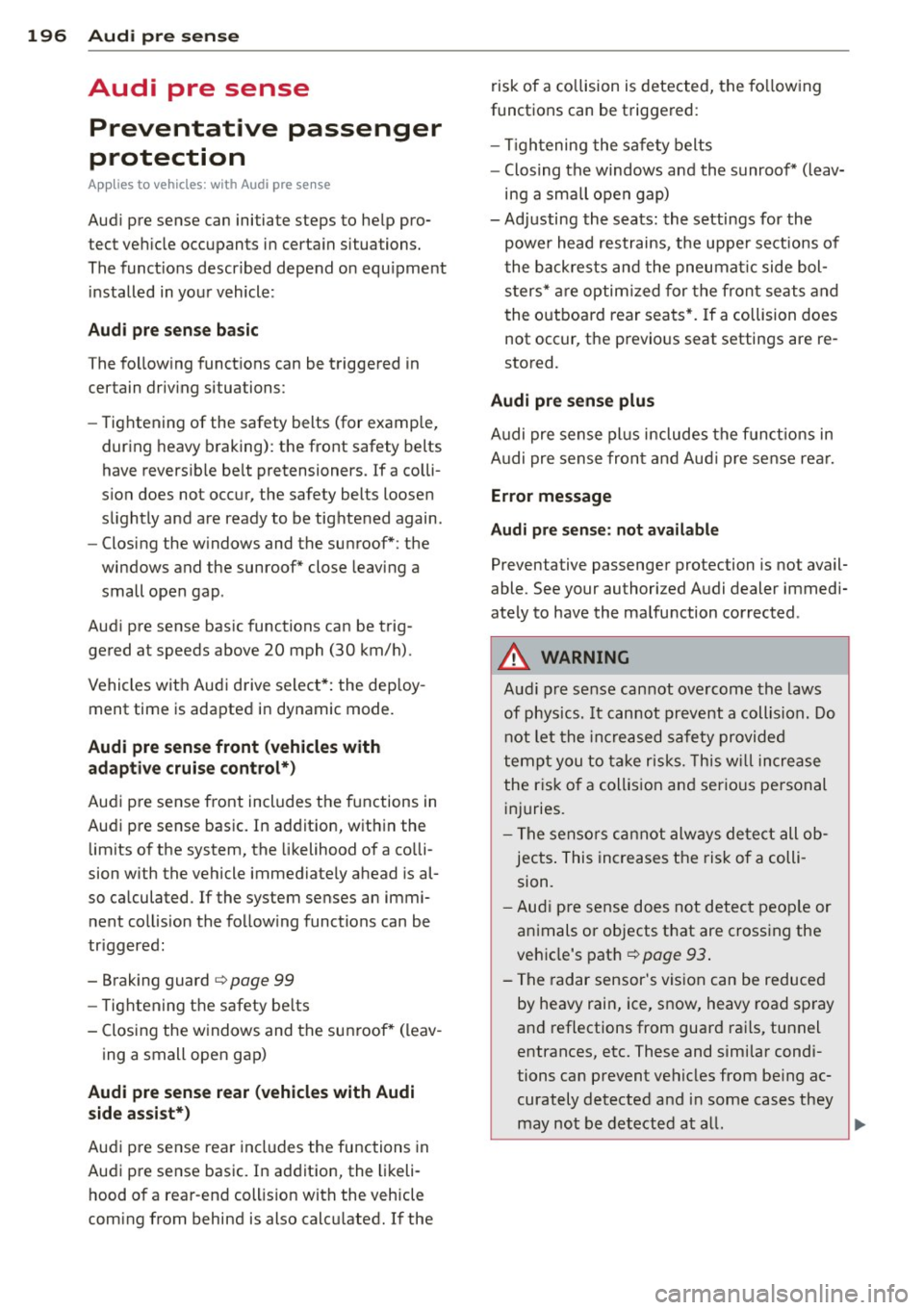
196 Audi pre sense
Audi pre sense
Preventative passenger
protection
A pp lies to veh icles: with Audi pre se nse
Audi pre sense can initiate steps to help proĀ
tect vehicle occupants in certain situations.
The functions described depend on equ ipment
installed in your vehicle:
Audi pre sense basic
The following functions can be triggered in
certain driving situations:
- Tightening of the safety belts (for example,
during heavy braking) : the front safety belts
have reversible belt pretensioners. If a colliĀ
sion does not occur, the safety belts loosen
slightly and are ready to be tightened again.
- Closing the windows and the sunroof*: the
windows and the sunroof* close leaving a
small open gap.
Audi pre sense basic functions can be trigĀ
gered at speeds above 20 mph (30 km/h).
Vehicles with Aud i drive select*: the dep loyĀ
ment time is adapted in dynamic mode.
Audi pre sense front (vehicles with
adaptive cruise control*)
Audi pre sense front includes the functions in
Audi pre sense basic. In addition, within the
limits of the system, the likelihood of a colli Ā
sion with the vehicle immediately ahead is alĀ
so calculated . If the system senses an immiĀ
nent collision the following functions can be
tr iggered :
- Braking guard
c::> page 99
- Tightening the safety be lts
- Closing the windows and the sunroof* (leav -
ing a small open gap)
Audi pre sense rear (vehicles with Audi
side assist*)
Audi pre sense rear includes the functions in
Audi pre sense basic. In addition, the likeliĀ
hood of a rear-end collision with the vehicle
coming from behind is also calcu lated.
If the risk
of a co llision is detected, the following
functions can be triggered:
- Tig htening the safety belts
- Closing the windows and the sunroof* (leav-
ing a small open gap)
- Adjusting the seats: the settings for the
power head restrains, the upper sections of
the backrests and the pneumatic side bolĀ
sters* are optim ized for the front seats and
the outboard rear seats*. If a collision does
not occur, the previous seat settings are reĀ
stored.
Audi pre sense plus
Audi pre sense plus includes the funct ions in
Audi pre sense front and Audi pre sense rear.
Error message
Audi pre sense: not available
Preventative passenger protection is not availĀ
able. See your authorized Audi dealer immediĀ
ately to have the malfunction corrected .
A WARNING
-Audi pre sense cannot overcome the laws
of physics.
It cannot prevent a collision. Do
not let the increased safety provided
tempt you to take risks. This will increase
the risk o f a collision and serious personal
injuries.
- The sensors cannot always detect all obĀ
jects . This increases the risk of a colli Ā
sion.
- Audi pre sense does not detect people or
animals or objects that are crossing the
vehicle's path
c::> page 93.
-The radar sensor's vision can be reduced
by heavy rain, ice, snow, heavy road spray
and reflections from guard rails, tunnel
entrances, etc. These and similar condiĀ
tions can prevent vehicles from be ing acĀ
curately detected and in some cases they
may not be detected at all.
Ill>
Page 199 of 318
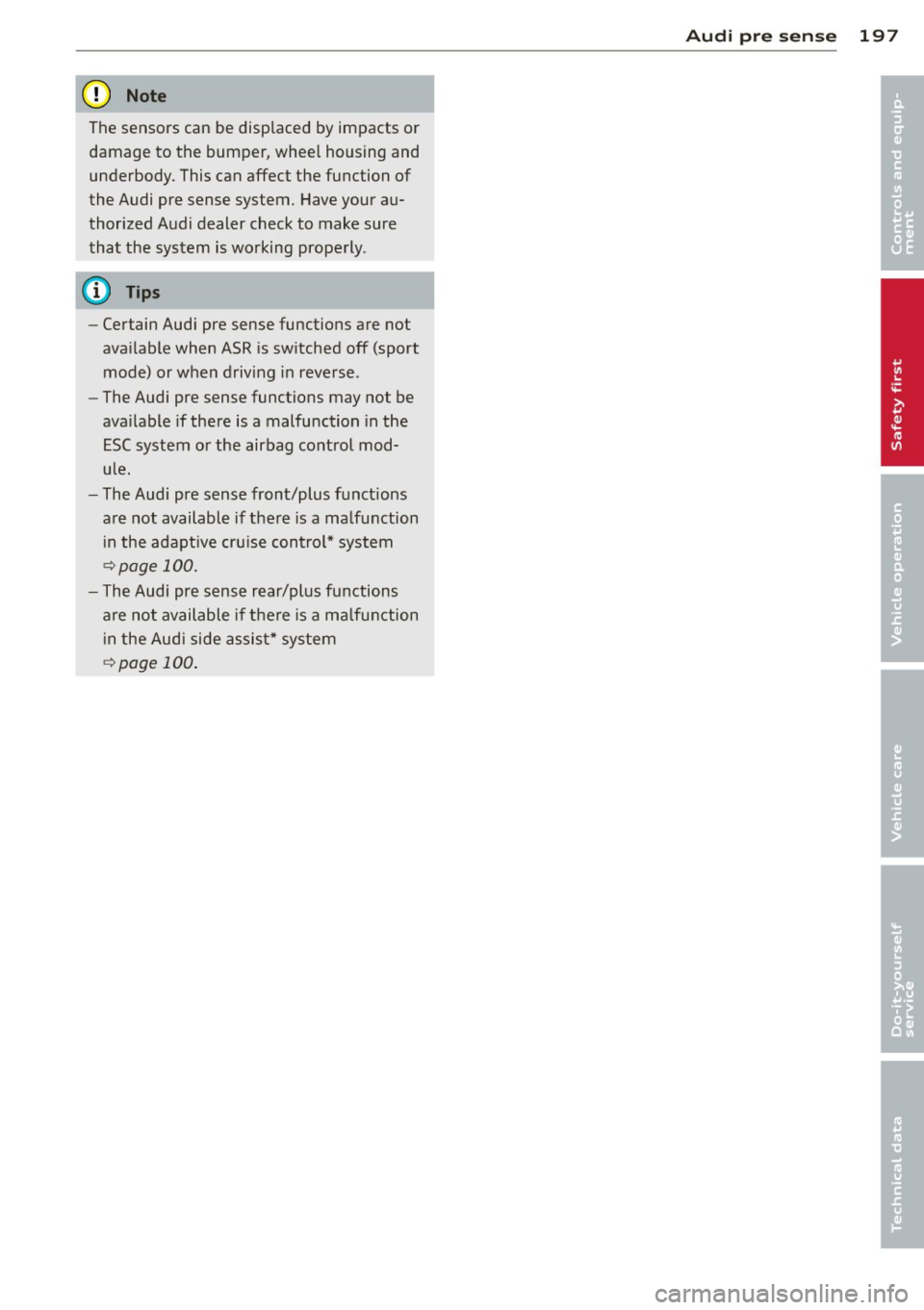
(D Note
The sensors can be displaced by impacts or damage to the bumper , whee l housing and
underbody. This can affect the function of
the Audi pre sense system. Have your auĀ
thor ized Audi dealer check to make sure
that the system is working properly .
(D Tips
-Certain Audi pre sense functions are not
available when ASR is sw itched off (sport
mode) or when driving in reverse .
- The Audi pre sense functions may not be
ava ilable if there is a malfunction in the
ESC system or the airbag control modĀ
u le.
- The Audi pre sense front/plus functions
are not available if there is a ma lfunction
i n the adapt ive cru ise control* system
Ā¢ page 100.
- The Audi pre sense rear/plus functions
are not available if there is a ma lfunction
i n the Audi side assist* system
Ā¢ page 100 .
Audi pr e sense 197
ā¢
ā¢
Page 205 of 318

Driving with your
quattro Ā®
With All Wheel Drive, all four wheels are drivĀ
en .
Gene ral inform ation
W ith All Whee l Drive, power is distributed to
all four wheels . This happens automatically
depending on your driving style and the road
conditions at the t ime. See also
t::;> page 198.
W ith the spo rt differential*, power d istribuĀ
tion to the rear wheels is variable and can be
adj usted with Aud i drive select*
t::;> page 109.
Always read and fo llow safety precautions
c:> .&. .
Winter t ires
When driving in the winter , your vehicle with
All Wheel Dr ive has an advantage, even with
regular t ires. In winter road conditions it may
be advisable to mount winter tires (or all-seaĀ
son tires) for improved driveability and brakĀ ing: these tires must be mounted on
a ll four
w he els .
See also c:> page 264, Winter tires.
Sn ow cha ins
Where snow cha ins a re mandatory on certa in
roads, th is normally a lso applies to vehicles
with A ll Wheel Drive
c:> page 265, Snow
chains .
Replacing whe els/ tires
Vehicles w ith All Whee l Dr ive must always
have tires of the same size. Also avoid t ires
with different tread depths. For details see
page
c:> page 260, New tires and replacing
tires and wheels .
Off-Road driving?
Your Audi does not have enough ground clearĀ
ance to be used as an off-road vehicle.
It is
therefore best to avoid rough tracks and un Ā
even terrain as much as possible. Also refer to
c:> page207.
Int ellig ent technolog y 203
A WARNING
Always adjust your driv ing to road and trafĀ
fic conditions. Do not let the extra safety
afforded by All Wheel Dr ive tempt you into
taking extra risks .
- Although the All Wheel Drive is very efĀ
fective, always remember that braking capacity is lim ited by tire t raction. You
should therefore not d rive at excessive
speeds on icy or slippery road surfaces.
- On wet road surfaces, be careful not to
drive too fast because the fron t wheels
could begin to slide on top of the water (aquaplaning) . If this should occur, yo u
will have no warning from a s udden inĀ
crease in engine speed as w ith a frontĀ
wheel drive veh icle. Always drive at
speeds which are su ited to the road conĀ
ditions - risk of crash.
Energy management
Starting ability is optimized
Energy management controls the distribution
of electrical energy and thus optimizes the
availability of electrical energy for starting
the engine .
If a vehicle with a conve ntiona l energy system
is not drive n for a long per iod of t ime, the batĀ
tery is discharged by idling current consume rs
(e.g . immobilizer). In certain circumstances it
can resu lt in the re being insuff icient energy
available to start the engine.
Intelligent energy management in your vehiĀ
cle handles the distribution of e lectrica l enerĀ
gy. Starting ability is marked ly improved and
the life of the battery is extended.
Basica lly, energy management consists of
b atte ry diagno sis, i dling current man ageĀ
ment
and d y namic ene rg y management .
Battery diagno sis
Battery diagnosis continuously determines
the sta te of the battery. Sensors determine
battery voltage, battery current and battery
Ii),,
ā¢
ā¢
Page 219 of 318

(D Note
-Never try to remove dirt, mud or dust if
the surface of the vehicle is dry. Never
use a dry cloth or sponge, since this
could scratch your vehicle's pa int or w inĀ
dows .
- Never wash your car in bright sunlight.
Drops of water act as magnifying lenses
and may damage your paint.
- When you wash your car in the w inter : if
you r inse your vehicle w ith a hose, be
careful not to aim the stream of water
direct ly at locks, or at door or hatch
openings - they can free ze shut.
- Never use sponges des igned to remove
i nsects, or any kitchen scouring sponges
or similar products. They can damage
you r paint finish .
- Never use a dry cloth o r sponge to clean
the headligh ts. On ly use we t cloths or
sponges to prevent scratches .
It is best
to use soapy wate r.
- You sho uld remove debris (su ch as inĀ
sects) from the head ligh t lenses on a
r egular basis, for example when refuel Ā
ing your vehicle . Never clean the headĀ
li ghts w ith a dry cloth or sponge. Use a
wet cloth or sponge. It is best to use
soapy water.
@ For the sake of the environment
On ly wash the vehicle in facilit ies specially
designed for that purpose. Th is w ill reduce
the risk of d irty water contaminated with
oil from entering the sewer system . In
some areas, wash ing vehicles outs ide of
these facilit ies is prohib ited.
Washing your vehicle with a power
washer
Cleaning the exterior of your car with a high Ā
pressure power washer is safe as long as you observe a few simple rules .
~ Before usi ng the power washe r, make sure
yo u have re ad an d u nderstood the WARN-
Cleaning and protec tion 217
INGS Ā¢ A in General information on
page 215 .
~ Always follow the operating instr uctions for
the power washer.
~ Make sure that the jet on the spray hose
produces a "fan shaped spray" .
~ Do not hold the spray nozzle too close to
soft mater ials .
Keep a distance from soft materia ls suc h as
rubbe r hoses or insulating material as well as
senso rs and camera lenses .
When cleaning the vehicle with a power was hĀ
er
always follow the operating instructions .
This applies part icu larly to the operati ng pres Ā
su re and the spraying d istance . Do not point
the spray d irectly at the seals around the side
windows, around the doo rs, on t he rear lid or
o n the sunroo f*. L ikewise, do no t poi nt i t diĀ
re ct ly a t tires, rubbe r hoses, insula tion mate Ā
ria l or senso rs ~
page 218 . Hold the spray
nozzle at least 1.3 ft (0.4 m) away from the
vehicle.
Do no t use a high-pressure power was her to
remove snow and ice.
Do not use a jet which sprays wate r in a d irect
stream o r one that has a ro ta ti ng jet.
Water temperature should not exceed 140 Ā°F
(60 Ā°().
&_ WARNING
N eve r wash tires wi th a jet that sprays w aĀ
ter in a direc t stream . T his co uld ca use inĀ
v isi ble damage to the t ires and weaken
them, even i f the spray is from a re lative ly
l ong distance and for a sho rt time. Dam Ā
aged and weakened tires can fail and cause
accidents and personal in jury.
Q) Note
To avoid damaging yo ur vehicle, a lways
make sure that there is suffic ient d istance
between the spray head and soft materia ls
lik e rubber hoses, plast ic parts a nd soundĀ
deaden ing mater ia ls as well as sensors
and camera lenses . Never a im t he spray
head at the same point fo r a long time .
ā¢
ā¢